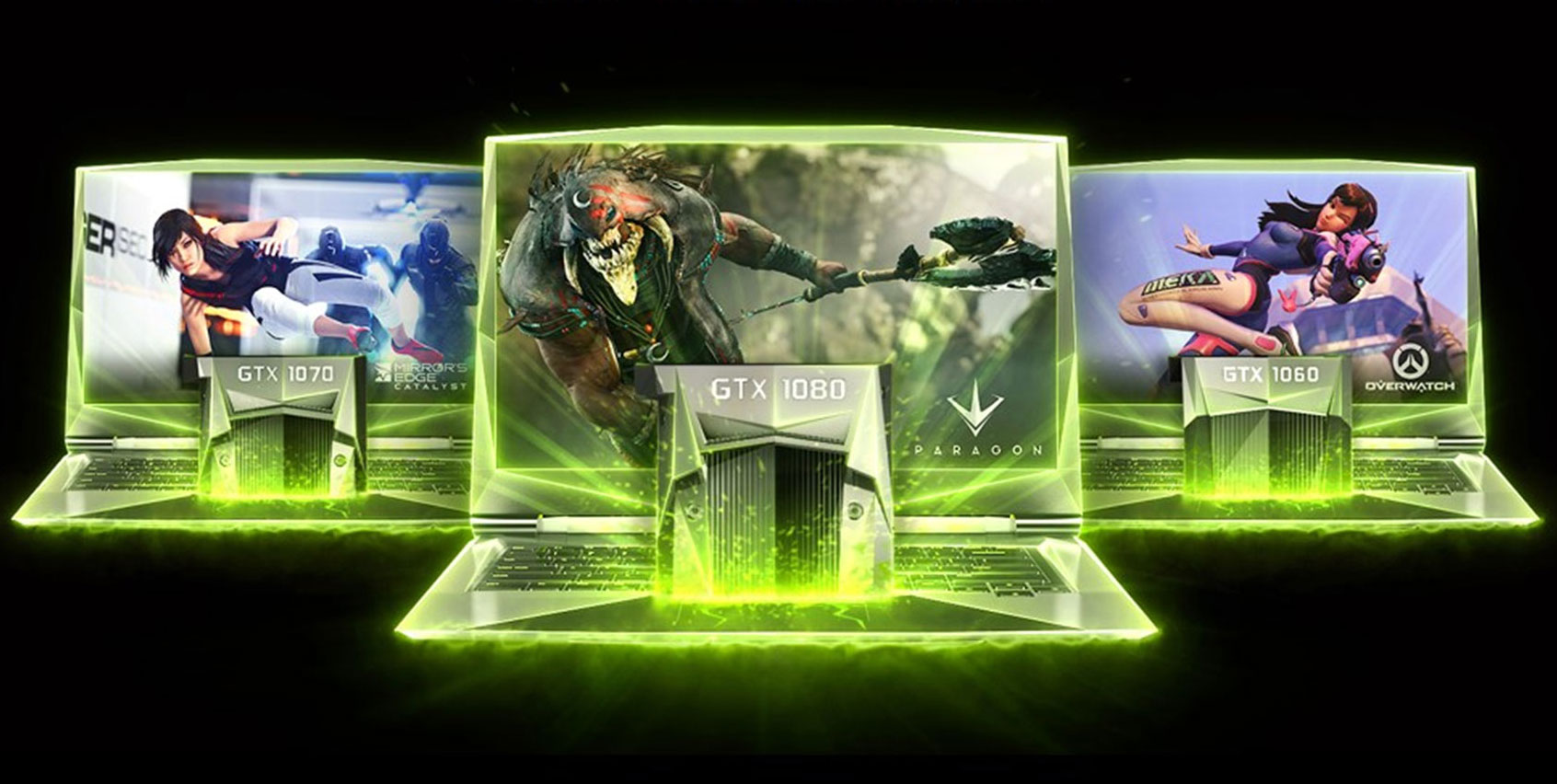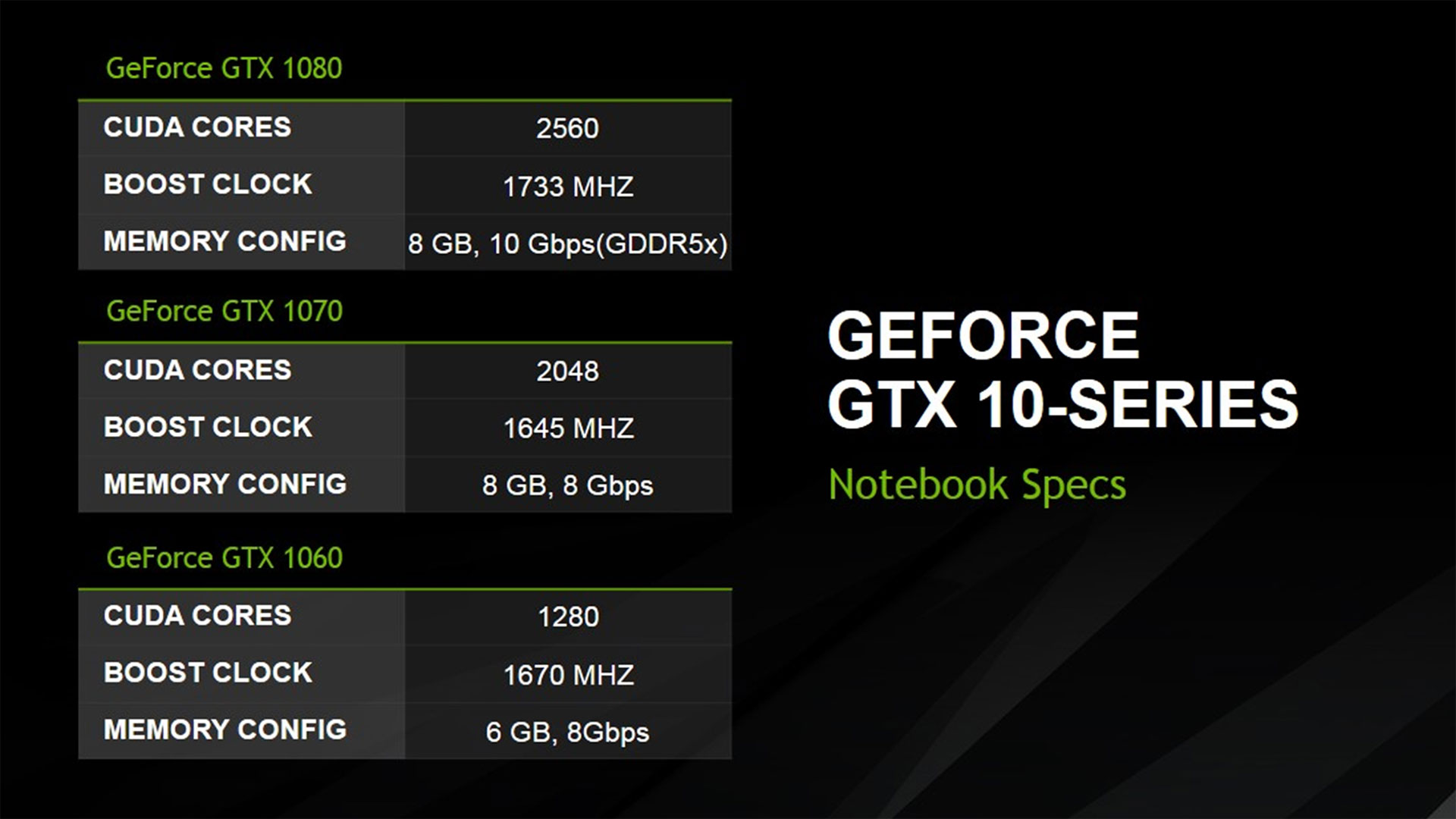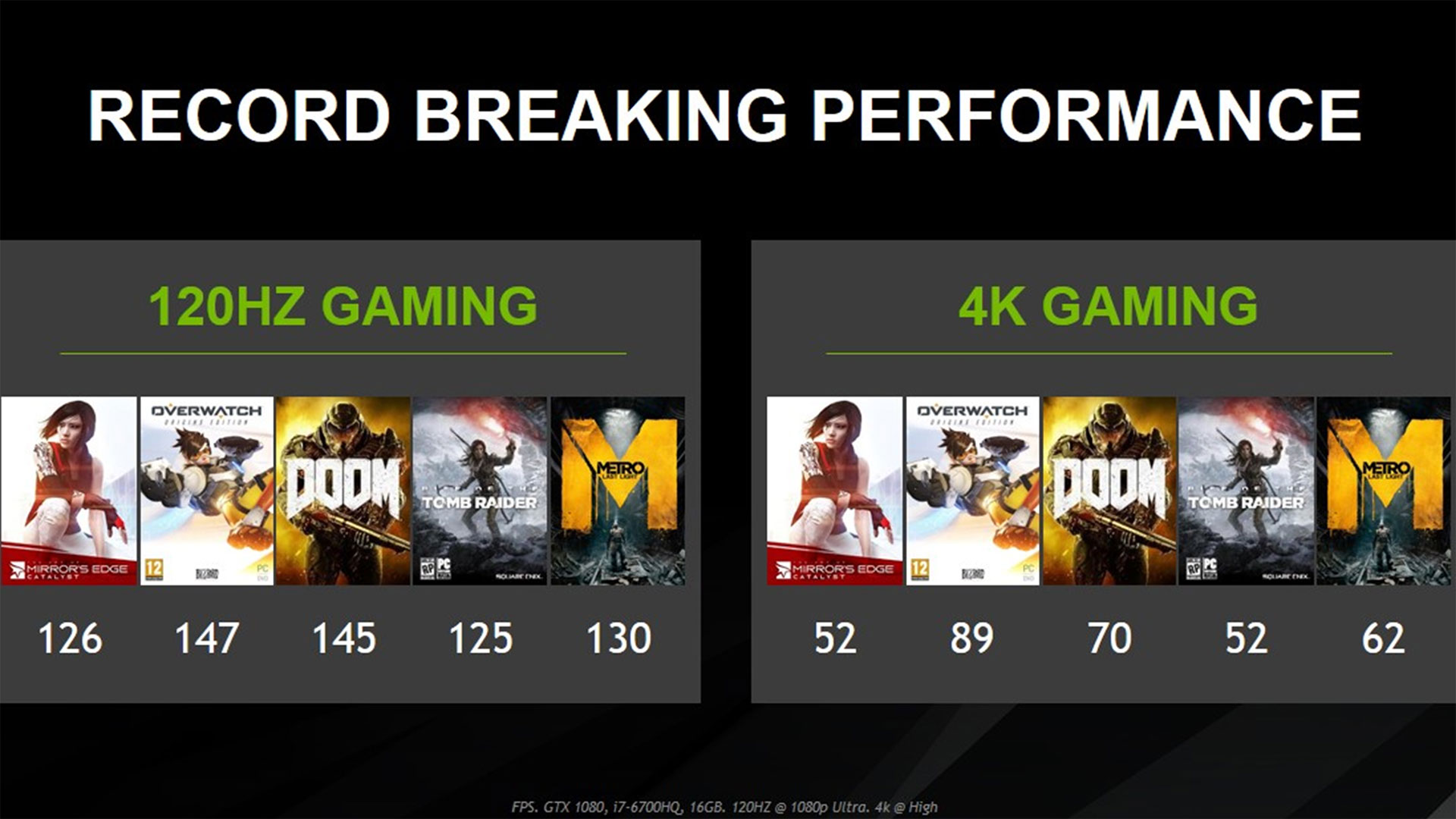Nvidia launches GeForce 10-series notebook GPUs
Same name, similar performance, slightly different specs than desktop models.

What's the fastest growing market segment in the gaming hardware industry? According to Nvidia, it's gaming notebooks, with sales increasing another 30 percent during the past year, and a 9X increase in sales over the past five years. Some of that undoubtedly comes down to the definition of 'gaming notebook,' which for Nvidia means a GTX graphics chip, but their internal numbers are still compelling. At present, they peg the total number of installed gaming notebooks during the past 3.5 years at 20 million. If that doesn't sound very good, then consider the install base for Xbox One is 29 million and PlayStation 4 is 52 million. Given the current rate of growth, there will be more active gaming notebooks in the wild in the next two years than there are Xbox One users. Of course consoles have other 'features' like a static hardware platform, but let's not dig too deeply.
The benefits of gaming notebooks compared to consoles is pretty easy to summarize, and there's a lot of overlap with the benefit of PC gaming in general. Gaming notebooks run on an open platform (no, Windows Store, we're not talking about you), they're powerful, and they're also highly portable. But there's been a problem with gaming notebooks going back pretty much as long as they've existed: Their graphics cards and processors have always been second class citizens. Compare a GTX 980M to a desktop GTX 980 and you'll find the desktop card is about 30 percent faster—it has 2048 cores running at around 1.2GHz with 7Gbps GDDR5, while the 980M has 1536 cores running at 1.1GHz with 5Gbps memory.
Similar comparisons can be made between many other mobile/desktop cards, but Nvidia made some changes last year when they launched the GTX 980 for notebooks—a full-fat card with performance nearly identical to the desktop 980. It looks like that change of tune is carrying over to the GeForce 10-series notebooks, with three new models all slated to launch today. These three new notebook GPUs all have the same name as their desktop counterparts, the GTX 1080, GTX 1070, and GTX 1060—and note the lack of an 'M' at the end. In terms of specifications, Nvidia didn't reveal all aspects of the GPUs, but they said the memory configurations and clocks are the same as the desktop models, and the performance in general should be "very close."

This slide shows some of the core specs for the notebook GPUs, though Nvidia does avoid listing base clocks (which are 1556, 1442, and 1404 MHz for the 1080, 1070, and 1060). The GTX 1080 has the same core count and boost clock for both notebook and desktop models, and the GTX 1060 is very nearly the same—the desktop has a 1708MHz boost clock, so about two percent higher. The GTX 1070 ends up being the most interesting chip of the bunch, because it has an extra SM (128 cores plus eight TMU) compared to the desktop model, along with a slightly lower clock speed, resulting in what appears to be a net four percent gain in performance. That's still close enough that they're effectively tied, but this is definitely not a repeat of the 900M series.
These are all the base specifications, however, and Nvidia is giving notebook vendors more freedom than before. Overclocking of all 10-series notebook chips is allowed (though it will be up to the notebook vendors to enable the feature), which is similar to what happened with the GTX 980 for notebooks last year. Interestingly, thanks to power and efficiency improvements, Nvidia says that where the notebook 980 typically only managed around a 100MHz overclock, they're getting up to 300MHz overclocks on the 10-series notebook parts. Also worthy of mention is that Nvidia will be allowing factory overclocked notebook GPUs this round, so larger notebooks and/or models with better cooling could potentially ship at speeds 20 percent faster than stock.
What does all of this mean relative to existing gaming notebooks? Nvidia states that on average, the new 10-series GPUs will be around 75 percent faster than the existing 900-series models, though some clarification is in order. The 1060 is actually being pegged as a replacement for the GTX 970M and not the rather anemic 960M; similarly, the 1070 takes over for the GTX 980M, and the 1080 replaces the GTX 980 for notebooks. Whether that's for pricing, power, performance, or all of the above isn't entirely clear, but our testing of desktop cards puts the 1070 as around 70 percent faster than the 970, which is about 50 percent faster than a 970M. Or put another way, the GTX 1060 is anywhere from 60 percent to 115 percent faster than a GTX 970M for the tests I've run, so the performance element looks about right. As for power, Nvidia doesn't officially disclose TDPs for mobile parts, but they appear to be similar to the existing 900-series parts. Besides improved performance, the new notebook GPUs will support all of the same features as the desktop Pascal chips.

The jump in performance also means all of these new gaming notebooks will officially be VR ready, which means if you're willing to finagle your notebook into a backpack and connect a VR headset (plus some additional power), you could cut the VR wires—for an hour or so before your notebook needs recharging, at least. And battery life has also received some improvements, mostly thanks to the more efficient 16nm FinFET fabrication process, I suspect. Nvidia claims up to 30 percent better battery life while gaming, presumably with Battery Boost enabled. Assuming a 30 fps target, it would make sense that the newer, faster GPUs are able to conserve more power than the previous generation. Battery Boost has also received some software tweaks that help to stabilize frame rates with less jitter, though, which is welcome news.
The biggest gaming news, reviews and hardware deals
Keep up to date with the most important stories and the best deals, as picked by the PC Gamer team.
Last but not least, on the display front Nvidia also has a couple of new additions to the G-Sync family. Previously, notebooks with G-Sync were limited to 75Hz panels (30-75Hz refresh rates). Whether that was due to power savings, lack of appropriate display hardware, or the feeling that notebooks GPUs simply weren't fast enough to warrant anything more isn't entirely clear, but it's likely a combination of all those factors. Notebooks using the new 10-series GPUs will have some of those constraints eased, and Nvidia says we'll see both 120Hz 1080p G-Sync panels as well as 60Hz 2560x1440 panels. Nvidia didn't provide the lower bound on refresh rates, but 30Hz is likely in both cases—especially considering the potential for using Battery Boost.
What will all of this cost you? If you were already in the market for a gaming notebook, it appears the GTX 1060 will supplant existing 970M configurations. Pricing and other features aren't really in Nvidia's control here, but they did say we should see 1060 notebooks starting at $1300. We'll have to see what actual retail pricing looks like, but 970M notebooks launched at roughly the same price, while these days it's possible to nab a GTX 970M notebook for as little as $1000. All the usual suspects, including Acer, Alienware, Asus, Clevo, HP, Lenovo, MSI, Razer, and more will be offering 10-series gaming notebooks. Nvidia couldn't disclose exact availability dates for the various manufacturers, but we're told to expect at least some models to go on sale tonight or tomorrow.
For notebook gamers, this level of performance parity has been a longtime dream. Now, the question of gaming desktop or laptop has become one of price versus portability, with performance no longer being a limiting factor. Yes, price is still very much in favor of desktops, as our budget gaming PC guide shows what $700-$800 can get you…but that doesn't include the screen, keyboard and mouse, or OS, which is potentially another $300. We'll even see SLI GTX 1080 and 1070 notebooks, and since 3-way and 4-way configurations are basically going the way of the dodo, we're closer now than ever before to replacing our desktops. The king is dead; long live the king!
Jarred's love of computers dates back to the dark ages when his dad brought home a DOS 2.3 PC and he left his C-64 behind. He eventually built his first custom PC in 1990 with a 286 12MHz, only to discover it was already woefully outdated when Wing Commander was released a few months later. He holds a BS in Computer Science from Brigham Young University and has been working as a tech journalist since 2004, writing for AnandTech, Maximum PC, and PC Gamer. From the first S3 Virge '3D decelerators' to today's GPUs, Jarred keeps up with all the latest graphics trends and is the one to ask about game performance.


